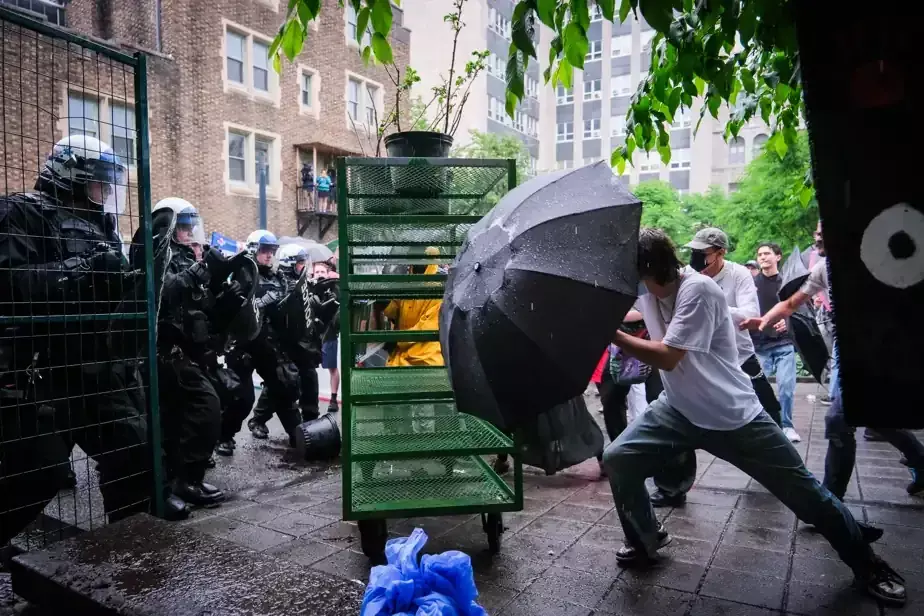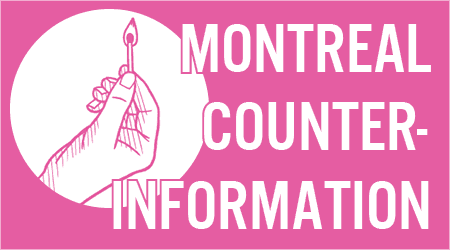
Anonymous submission to MTL Counter-info
A summary of events
At around 4 PM, student protesters entered the James administration building of McGill University and disrupted the Board of Governors’ (BoG) meeting to oppose its complicity in the genocide in Gaza. The BoG is the highest instance of the university and decides in which companies its endowment fund is invested, including Israeli, Zionist and arms companies. Hundreds of protesters formed a support rally around the building, with some creating makeshift barricades with fences and furniture. An hour later, on the administration’s request, a strong police presence arrived on campus, including several dozen riot cops. The latter took control of the walkway east of the building and prevented protesters from protecting the north (back) entrance, thus confining them to the south (front) side of the building.
At around 6:30 PM, cops entered the building through the back entrance. They would soon begin arresting the protesters inside, who had tried to barricade the room they were in as best as they could. Simultaneously, cops brutally assaulted the support rally, using their batons, pepper spray and tear gas to disperse the protesters, who did not go out without a fight.

The level of violence from the police surprised some demonstrators, with cops aiming tear gas or rubber bullet guns at people’s heads and intentionally shooting people with tear gas canisters, in addition to using huge quantities of chemical irritants.
At 7:15 PM, a demo started marching from the UQAM (another university) encampment towards McGill. The march symbolized the end of said encampment and had been announced several days prior; it was therefore not in direct reaction to the James building occupation, though its path might have been rerouted for the occasion. Protesters meandered through the Milton-Parc neighborhood to try to reach the administration building, but their attempts were thwarted by police following them and blocking streets. The demo finally tried to break through the police line on Milton street, just a mere hundred metres east of the James building. Protesters were then met with the violence and pepper spray of bike cops, backed up by riot police. In the disorientation that ensued, the protesters ran away and, one way or another, reached the Lower Field.
The UQAM crowd slowly regrouped there, joining forces with the McGill one. Those who were still good to go started marching again, unabated by the torrential rain. The demo meandered through the streets, with riot cops clearly blocking any road that might lead to the James. Once on Sherbrooke, a Scotiabank window was shattered. The protest continued wandering through Milton-Parc and went east, eventually disbanding on St-Laurent.
Some thoughts
The author of these reflections applauds everyone who partook in the occupation or the demos, and hopes the following thoughts are not taken as negative criticisms, but as things to think about, discuss and debate moving forward.
1. On communication: publicly announcing the BoG meeting on social media would have made the James occupation impossible, as the administration would have called the cops beforehand or moved the meeting online. However, I still think it would have been useful if McGill folks had shared the information with trusted UQAM folks. For one, this could have allowed the latter to advance their demo time and thus join the support rally. This would also have facilitated the exchange of knowledge and material, namely rope to allow the occupiers to escape through the windows and things to block the back entrance. On the last point, I think more intel should have been done to make sure every entrance had been dealt with.
2. On meteorological conditions: the heavy rain created unique conditions with some payoffs. While it might have discouraged more people from attending the demo, it somewhat mitigated the spread of pepper spray and tear gas and provided a good reason to bring umbrellas. Of course, goggles and masks still proved useful that day. The wind also made its presence known: there is footage of riot cops teargassing themselves because of it. Weather conditions and terrain geography (elevation, obstacles) still seem to be relatively unexplored areas of demo planning.
3. On objectives: both the march from UQAM and the subsequent one from Lower Field apparently had the goal of reaching the James. Other than its symbolic significance, this objective makes little sense in my opinion, since the cops had already entered the building before the first march was on its way. Also, the long meandering paths taken did not help reach the destination, as the cops could always see where we were headed. Nevertheless, the persistence and temerity of the protesters is worth acknowledging and commending. Older comrades even said the demo reminded them of combative night demos from 2012.
4. On demo formations: the UQAM demo had a few standoffs with the police, who were adamant on preventing it from getting to the James. As explained in the previous point, I still have difficulty understanding that objective. However, there might come a point in time where similar ones prove crucial in achieving wider goals. I will thus share my two cents on two noteworthy standoffs:
– The first one happened with bike cops preventing further advancing on Prince-Arthur street. After stopping for a brief while, protesters started marching again towards the cops, yelling “Bouge!” (Move!) to give them a taste of their own medicine. Some rocks were also thrown (albeit not very powerfully). Despite the comedic value of the whole scene, the cops did not cede, with some deploying pepper spray and others threatening the crowd with their bikes. The demo thus chose to turn away. In my opinion, the demo did not charge fast enough to instill psychological fear in the cops. It is somewhat understandable though, since the protesters didn’t have much in the way of equipment to neutralize the bicycles.
– The second standoff occurred on Milton street, where police vans were spread throughout the street and reduced mobility for both sides. Once again, the protesters faced bike cops, but this time, they made contact, as their resolve had hardened. The first three rows respectively held the following items: banner – umbrellas – flagpoles. The protesters held the line for a while, but fell into disarray after the cops made liberal use of pepper spray and riot cops arrived on the scene. I think that with more training, discipline and experience, the demo could have stayed grouped while the medics attended to those who had gotten sprayed. This would have prevented the ensuing disorganized and individualistic retreat. I also think that expanding the demo onto the sidewalks and attacking by the flanks (while still leaving an escape route for the cops) would have proven strategic.
Another tactic worth thinking about when cops deny entry to an area is the splitting of the demo into two or more groups, provided that they remain big enough. Each would take a different road to try and spread the police force thin. This allows the protesters to increase their surface area, i.e. the number of people directly facing the cops instead of waiting in the middle of a crowd. Needless to say, the successful execution of such maneuvers would require prior training and constant communication between the groups.
5. Be like water: our force stems from our ability to be anywhere and everywhere, whether it be at a protest or other actions. According to many comrades, the riot cops’ priority seemed to be to guard the James building. This limited their range of motion, and other types of cops seemed more interested in following the demo than protecting other potential targets, like the Scotiabank. On a broader level, the events illustrate an asymmetry between the people and state forces: the former, like steppe cavalry, have a harder time defending places, but are more agile; the latter, like heavy infantry, are stronger in direct confrontations (unless at a significant numerical disadvantage), but less mobile. While the police has various vehicles at their disposition, they can be slowed down by dragging objects into the street. Now, I am well aware that habit gets a bad rep because it doesn’t really slow down riot cops and can constitute a tripping hazard for ourselves. That being said, in narrower streets, it proved useful in creating some distance from bike cops and vans and giving protesters some time to regroup after a rout.


